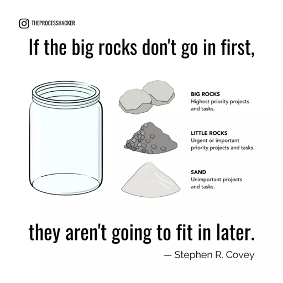Workplace and Efficiency: Rocks and a Functional Team, by Nia Alexieva of Conference Compass

Dysfunction 1: Absence of Trust
Dysfunction 2: Fear of Conflict
Dysfunction 3: Lack of Commitment
Dysfunction 4: Avoidance of Accountability
Dysfunction 5: Intention to results

Jelmer van Ast is the CEO and founder of Conference Compass: a company that provides a virtual event engagement platform for associations, corporations and professional conference organisers. Over the last two MESA meetings, Jelmer has shared some incredibly valuable insights that we all could take as an example and apply to our workspace, or even… to our daily lives!
Firstly, know your rocks!

Jelmer has been incorporating the EOS model in the workplace. The model is based on defining what is most important for each team and its members, in a 90-day time frame.
1. Choose your "Rock"
In the beginning of a 90 day cycle, everybody needs to define their rocks. A rock is a goal or a vision that each member wants to complete by the end of the cycle. Each team discusses the chosen rocks and whether they should be “kept,” “killed” or “combined” with the rock of somebody else.
2. On-track or off-track?
Each week, all members of the team will get together and update each other on the progress of the rock: is it on-track, off-track or completed? In this process the team member can bring up any issues that have come up while working on the rock, ask the other members for advice, or just brainstorm. This way everybody is aware of the progress made and the work that goes into achieving the goal.
3. The Rock Festival
Finally, every three weeks there is the so-called Rock Festival: where all teams from the entire company gather together and share their rocks and the progress that they have made so far. This is the stage at which questions can be asked and ideas are exchanged. The whole company this way is aware of what all departments within the organisation are up to. They can provide their advice and own experience.
4. The end of the cycle
By the end of the 90 days the rock has either been completed or not. A completed rock is a great success and it shows that the goal was achievable and manageable within such a time frame. If a rock is not completed, the journey does not end there. Members can learn a lot from this. Was the goal not realistic? Were other issues of greater priority? Was there a major hurdle that simply could not be overcome? Answering these questions will aid reflection and evaluation and contribute to smarter goal-setting in the future.
Discussion and execution of the rocks all happens within the structure of a team. Even if somebody is working on a personal goal, one way or another it will contribute to the work of a collective. A well executed rock on a personal level, will not succeed if a team is dysfunctional. Which is the second lesson that Jelmer wants to teach us all.
Team Dysfunctions
Jelmer introduces us to a book called The Five Dysfunctions of a Team - A Leadership Fable by Patrick Lencioni. Lencioni introduces a pyramid that consists of layers: different dysfunctions that can exist within a team. It is normal for these issues to exist within a group structure, hence there also exists a way of solving them. A team leader is of pivotal importance in facilitating this fix.
Applying this model to our work environment means that we need to be able to:
- Identify the leader
- Identify the problem and its cause
- Applying the solution
Dysfunction 1: Absence of Trust
Trust is the foundation of a well working team. If a team lacks trust, that means that nothing will be working out (Hence, this dysfunction’s position at the bottom of the pyramid). The cause of this issue is that members do not feel comfortable with being vulnerable: admitting mistakes, asking for help, etc. A team leader needs to show that they themselves can be open and vulnerable, and the others will follow.
Dysfunction 2: Fear of Conflict
Team members can often feel like there is no grounds for a productive and safe way of sharing concerns and expressing constructive criticism because of fear of conflict within the team. This means that internal communication will be very limited and will not create a productive environment. As a team member, you need to show that productive conflict is necessary. Get the ball rolling by encouraging others to express themselves and by doing so yourself.
Dysfunction 3: Lack of Commitment
If the previous issues have been resolved, it means that it is time to get the ball rolling: setting goals and creating action plans. The issue that often arises here is that these goals can often be too ambiguous or not clear for team members to be able to execute them in the best way possible. This is why leaders need to make sure that the goals that are brought up are SMART:
Specific
Measurable
Attainable
Realistic
Time-bound
It may take some time to create a goal that ticks all these boxes, but this will get people thinking and will force them to commit to something that is achievable and realistic.
Dysfunction 4: Avoidance of Accountability
The successful completion of a task or goal depends on members of the team holding one another accountable. It is very hard to establish this as a standard within the team. Team leaders in such situations need to be quick with pointing out difficult issues and bringing them to the table, setting the example that others should do the same.
Dysfunction 5: Intention to results
In the structure of day-to-day work, it is very easy to start focusing on personal results, as opposed to what the team is achieving together. Leaders are the figures that remind the rest of the team that it’s the team results that come first, and then the rest. If the focus is repeatedly brought back to the team effort, the team goals will be naturally prioritised.
Jelmer’s lessons show us that there is always something that can be improved in the structure of our workplace. From goal-setting and execution, to the way that the work team operates on a day-to-day basis. Self-reflection is key to creating a better, more efficient and more happy team in the long run.
GO TO PREVIOUS BLOG - Embracing ownership and empowering yourself for success
Contact us now if you would like to share your News & Blog with us!